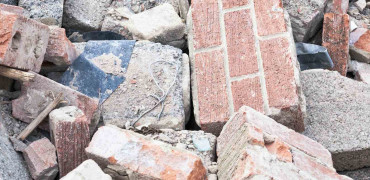The recent invasion of Ukraine and the swift sanctions imposed across Europe on Russia have dramatically affected many aspects of the construction industry and of course daily life.
Both the uncertainty of supply and the visibly rising costs of materials yet again raise the question of our sustainability across many industries.
Is it wise to be quite so reliant on the rest of the world?
Can the construction industry weather the extreme rise and fall we inevitably have to come?
The creation of densified wood can offer new design possibilities.
Time to steel ourselves
Building with materials readily available in the UK and Europe would not only address the immediate shortage of vital construction materials such as steel but could also improve our long-term climate emergency.
The price of steel jumped during Covid and has remained high as we all watch in horror at the continuation of the war in Ukraine.
Both Russia and Ukraine are two of the world’s largest steel exporters and according to the Department for Business, Energy and Industrial Strategy (BEIS) the cost of fabricated steel has jumped by a huge 75%.
Perhaps it is time for political will to reflect the needs of society and alter the path of construction, perhaps accelerate towards a more natural future?
Forgive the pun but wood-based technologies are literally growing!
Wood you believe it?
Wood takes far less energy to produce than steel or concrete and more importantly can be sourced locally. Wooden buildings could also by their nature reduce carbon emissions.
Building with wood creates somewhere between 20-30% less greenhouse emissions than our current building methods which has to be a consideration.
Ultra-strong timber building materials can be made using adhesive to bond smaller wood strands or fibres together at perpendicular angles to create a laminated timber that has structural rigidity in both directions, CLT (Cross Laminated Timber).
Large, prefabricated beams, pillars, walls, floors can all replace steel. CLT is both strong and durable, more environmentally friendly, readily available, and relatively cheap.
It can provide dry, fast construction with a robust structure. It is suitable for most finishes required both internally and externally.
Let’s also remember that the manufacture of steel and concrete is not only expensive and precarious at the moment but also contributes to approximately 8% of our global carbon emissions, whilst wood as a natural and abundant resource does quite the opposite.
Lighter than steel but just as strong
Engineers at the University of Maryland have developed densified wood, a way to create a material that is compatible with carbon fibre in strength only much, much cheaper to produce.
Teng Li, the co-leader of the team and Samuel P. Langley, Associate Professor of mechanical engineering at UMD's Clark School have declared. "It is as strong as steel, but six times lighter. It takes 10 times more energy to fracture than natural wood. It can even be bent and moulded at the beginning of the process."
Production of CLT consumes only one tenth of the energy used to make conventional building materials and also continues to store carbon.
CLT is supplied to site as a prefabricated kit which reduces construction costs, time and waste. Importantly, CLT can be recycled.
Wood is abundant and the creation of densified wood can offer new design possibilities.
It allows researchers to create materials to suit the design they need rather than designing for the materials we have at hand.
Densified wood has obviously addressed the need for strength in the construction industry but other researchers are considering further goals such as transparency.
It is possible to imagine a future home made entirely from wood, perhaps even a car made from densified wood on your driveway….
Kirsty Hammond Editor of Specifier Review



